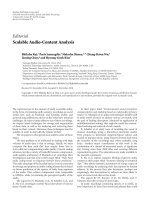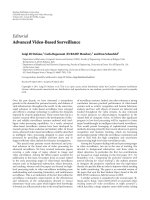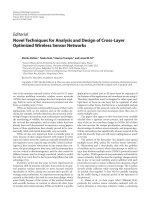Báo cáo hóa học: " Editorial ´ Herve Bourlard IDIAP, Rue du Simplon 4, CH- 1920 Martigny, Switzerland " pptx
Bạn đang xem bản rút gọn của tài liệu. Xem và tải ngay bản đầy đủ của tài liệu tại đây (658.3 KB, 3 trang )
EURASIP Journal on Applied Signal Processing 2004:4, 427–429
c
2004 Hindawi Publishing Corporation
Editorial
Herv
´
eBourlard
IDIAP, Rue du Simplon 4, CH- 1920 Martig ny, Switzerland
Email:
Ioannis Pitas
Department of Informatics, Aristotle University of Thessaloniki, Thessaloniki, TK 54006, Greece
Email:
Kenneth Kin-Man L am
Centre for Multimedia Signal Processing, Dep artment of Electronic and Information Engineering,
The Hong Kong Polytechnic University, Hong Kong
Email:
Yue Wang
The Bradley Department of Electrical and Computer Engineering, Virginia Polytechnic Institute and State University,
VA 24061-0111, USA
Email:
Biometric signal processing is an emerging technology that
enables the authentication, identification, or verification of
an individual based on physiological, behavioral, and molec-
ular characteristics. With the advancement of computer vi-
sion and pattern recognition techniques, together with high-
speed computers, research related to biometrics has devel-
oped rapidly in the last several decades, and has led to var-
ious applications. Biomet ric techniques include recognizing
faces, hands, voices, signatures, irises, fingerprints, DNA pat-
terns, and so forth. These enabling technologies for biomet-
rics will play an important role in security, smart card, and
personalized eCommerce applications. The analysis of bio-
metric information is a challenging task, and a wide range of
signal processing techniques has to be applied. The success
of the applications relies heavily on the efficiency, reliability,
and accuracy of these biometric signal processing techniques.
This special issue brings together researchers working on
biometric signal processing and its applications, with a par-
ticular emphasis on person authentication and identifica-
tion. In this special issue, we are pleased to present new tech-
niques as well as developments of the different signal process-
ing techniques and their applications. We have three papers
on speaker verification, two papers on fingerprint matching,
four papers on human face detection and recognition, two
papers on signature verification, and one paper on gait recog-
nition.
Speaker verification and fingerprint pattern recognition
are among the very first applications in biometric signal
processing. The first paper by Bimbot et al. is a tutorial
paper that provides an overview of a state-of-the-art text-
independent speaker verification system. A modular scheme
of the training and test phase of the system is introduced.
Gaussian mixture model and ceptral analysis, which are the
dominant techniques for speaker verification, are explained
in detail in this paper. Other speaker modeling alternatives,
scoring normalization, and the extension of speaker verifica-
tion techniques to other applications are also covered. This
is a useful paper for researchers working in this field. The
second paper by Mak et al. considers a new channel com-
pensation approach to telephone-based speaker verification.
This direction of speaker verification has attracted much at-
tention recently because of the proliferation of eBanking and
eCommerce, which require the verification of a speaker over
the telephone. The paper proposes to combine a handset se-
lector with stochastic feature transformation to reduce the
distortion caused by the limited bandwidth of the telephone
network. In addition, a divergence-based handset selector
with out-of-handset rejection capability to identify the un-
seen handsets is proposed. The last paper on speaker verifi-
cation is by Besacier et al., and it presents the investigation of
speaker verification over the Internet at the protocol level and
at the speech signal level. At the protocol level, the paper rec-
ommends the transmission of data models or features instead
of raw biometric data in order to reduce the transmission
time, and the use of encryption/decryption for enhancing
data security. At the signal level, the paper shows that packet
428 EURASIP Journal on Applied Signal Processing
loss is not a major problem for text-independent speaker au-
thentication. However, the use of a low bit rate coder will
greatly degrade the performance. The next two papers are
on fingerprint segmentation and recognition. The paper by
Chen et al. proposes a novel algorithm for the block feature-
based segmentation of fingerprints. Its major contribution
is an integrative approach to feature analysis and segmen-
tation. Adding morphological postprocessing, the method
could significantly improve the quality of segmenting finger-
prints with greatly reduced misclassification. The paper by
Yin et al. focuses on an accurate estimation of the ridge dis-
tance in fingerprint feature analysis. Its major contribution is
a balanced effort on both algorithm development and perfor-
mance evaluation. Due to the lack of much published work
on this topic, the paper could significantly motivate fertile
scientific discussions.
Research on human face recognition has been growing
rapidly over the last two decades. To identify a person in an
open environment, human face recognition is the most natu-
ral approach. This is because to collect useful data for recog-
nition, face recognition has the advantage of being nonin-
trusive, requiring little cooperation from the person being
identified. The paper by Jiang addresses the issues of detect-
ing human faces in a complex airport environment. The pa-
per presents a new variant of the AdaBoost to detect human
faces, namely, S-AdaBoost, which uses the AdaBoost distri-
bution weight as a dividing tool to separate the input face
space into inlier and outlier face spaces; dedicated classifiers
are then used to handle the inliers and outliers in their cor-
responding face spaces. This is an effective approach to lo-
cating human faces in a complex background. The accuracy
of detecting a human face and locating its respective facial
features has a direct impact on the performance of the face
recognition algorithms to be used. The next three papers are
also on face recognition. The paper by Perronnin et al. pro-
poses a novel approach to face recognition by modeling the
transformation between face images of the same person. The
transformation is approximated by means of a collection of
local transform ations with a constraint to make neighboring
transformations consistent with each other. Local transfor-
mations and neighboring constraints are embedded within
a probabilistic framework using 2D hidden Markov models
(HMMs). Another major contribution of this paper is the
introduction of the Turbo-HMM, which is an efficient tech-
nique to approximate intractable 2D HMMs. The next two
papers on face recognition consider the optimal conversion
of a color image to a monochromatic image and the com-
bination of different face recognition results, respectively, to
improve face recognition performance, instead of consider-
ing a new face recognition algorithm. The paper by Jones III
et al. proposes optimal methods to convert a color image to
a monochromatic image for face recognition. Actually, this
issue has not been considered in the current face recogni-
tion algorithms. Three approaches—Karhunen-Lo
`
eve analy-
sis, the linear regression of color distribution, and a genetic
algorithm—are explored to determine the optimal conver-
sion. The color-conversion methods are independent of the
face recognition approach being used, but can improve its
recognition performance. The other paper by Huang et al.
presents a way to achieve a better recognition performance
level by combining the classifier outputs based on d ifferent
face recognition techniques. The paper proposes three meth-
ods to combine the classifiers, namely, the normalization of
the classifier output, the selection of classifier(s) for recogni-
tion, and the weighting of each classifier.
Signature verification is also a commonly used biometric
identification technique. Signatures have been widely used
in bank and credit card transactions as a means of authen-
tication, and most computers or hand-held devices are also
equipped with I/O to allow handwriting input. In addition,
a signature or a piece of handwriting may be changed by the
user, but that is impossible with fingerprints, face, irises, and
so forth. This special issue has two papers on signature and
handwriting verification. The paper by Vielhauer and Stein-
metz presents an approach to derive biometric hashes based
on handwriting. The paper investigates the degree to which
each of the statistical feature parameters contr ibuted to the
overall intrapersonal stability and interpersonal value space.
A feature correlation method for feature analysis and selec-
tion is also proposed. The next paper by Coetzer et al. is on
offline signature verification. The paper proposes to use the
discrete Radon transform first to extract global features of
a scanned signature, and then to feed the features into the
HMM in order to model the signature. Most of the existing
signature verification approaches utilize local features. It is
likely that the algorithm proposed in the paper can be incor-
porated with other existing signature verification methods
based on local features to achieve a significant improvement.
The last paper in this issue is by BenAbdelkader et al.
They study human identification at a distance using gait
recognition. This research has recently attracted growing in-
terest from computer vision researches even though it is still
at its infancy. The paper describes a novel gait recognition
technique based on the image self-similarity of a walking
person. The major advantages of the method are that it is
correspondence-free, works well with low-resolution video,
and is robust to variation in clothing, lighting, and to seg-
mentation errors.
In summary, this special issue presents a wide range
of different biometric features and techniques for applica-
tions, such as speaker verification, fingerprint recognition,
face recognition, signature verification, and gait recognition.
We can foresee that developments in this field will become
even more rapid in the future. We hope that the techniques
presented in this issue will be of great use to researchers in
this field and will provide them with possible directions for
the development of biometric technologies. We wish to thank
all the authors for their contributions and all the reviewers
for their diligent efforts in evaluating and commenting on
the papers.
Herv
´
eBourlard
Ioannis Pitas
Kenneth Kin-Man Lam
Yue Wang
Editorial 429
Herv
´
e Bourlard received the Electrical and
Computer Science Engineering degree and
the Ph.D. degree in applied sciences both
from Facult
´
e Polytechnique de Mons, Bel-
gium. After having been a member of the
scientific staff at the Philips Research Labo-
ratory of Brussels and an R&D Manager at
L&H SpeechProducts, he is now Director of
the IDIAP Research Institute and Professor
at the Swiss Federal Institute of Technology
at Lausanne (EPFL), and Director of a National Center of Compe-
tence in Research in “Interactive Multimodal Information Manage-
ment.” He is also an External Fellow of the International Computer
Science Institute (ICSI) in Berkeley, Calif, and a member of the ICSI
Board of Trustees. H. Bourlard is the author/coauthor of 2 books
and over 180 reviewed papers (including one IEEE paper award)
and book chapters. He is an IEEE Fellow for contributions in the
fields of statistical speech recognition and neural networks. He is
(or has been) a member of the program and/or scientific committee
of numerous international conferences (e.g., General Chairman of
IEEE Neural Networks Signal Processing 2002, General Chairman
of Eurospeech’2003) and journals, and past Coeditor-in-Chief of
the Speech Communication journal. His main interests are in sig-
nal processing, statistical pattern classification, multi-channel pro-
cessing, artificial neural networks, and applied mathematics, with
applications to speech processing, speech and speaker recognition,
language modeling, computer vision, and multimodal processing.
Ioannis Pitas received the Diploma of Elec-
trical Engineering in 1980 and the Ph.D. de-
gree in electrical engineering in 1985, both
from the University of Thessaloniki, Greece.
Since 1994 he has been a Professor at the
Department of Informatics, University of
Thessaloniki, Greece. His current interests
are in the areas of digital image processing,
multimedia signal processing, multidimen-
sional signal processing, and computer vi-
sion. He has published over 450 papers, contributed in 17 books
and authored, coauthored, edited, or coedited 7 books in his area
of interest. He is the coauthor of the books Nonlinear Digital Fil-
ters: Principles and Applications (Kluwer, 1990) and 3D Image Pro-
cessing Algorithms (Wiley 2000). He is the author of the books Digi-
tal Image Processing Algorithms (Prentice Hall, 1993), Digital Image
Processing Algorithms and Applications (Wiley 2000), Digital Image
Processing (in Greek, 1999). He is the editor of the book Parallel
Algorithms and Architectures for Digital Image Processing, Computer
VisionandNeuralNetworks(Wiley, 1993) and coeditor of the book
Nonlinear Model-Based Image/Video Processing and Analysis (Wi-
ley 2000). He is a principal i nvestigator/researcher in more than 40
competitive R&D projects and in 11 educational projects, all mostly
funded by the European Union. He is Associate Editor of the IEEE
Transactions on Circuits and Systems, IEEE Transactions on Neu-
ral Networks, IEEE Tr ansactions on Image processing, IJIG, IEICE,
Circuits Systems and Signal Processing (CSSP), coeditor of Multi-
dimensional Systems and Signal Processing, member of the edito-
rial board of 6 journals and guest editor in 6 special journal issues.
He was Chair of the 1995 IEEE Workshop on Nonlinear Signal and
Image Processing (NSIP95). He was Technical Chair of the 1998
European Signal Processing Conference. He was the General Chair
of IEEE ICIP2001. He was Cochair of the 2003 International work-
shop on Rich media content production. He was Technical Cochair
of the 2003 Greek Informatics conference (EPY).
Kenneth Kin-Man Lam received his As-
sociateship in electronic engineering from
The Hong Kong Polytechnic University
(HKPolyU) in 1986, his M.S. degree in
communication engineering from the Im-
perial College of Science, Technology and
Medicine in 1987, and his Ph.D. degree
from the Department of Electrical Engi-
neering, University of Sydney in 1996. From
1990 to 1993, he was a Lecturer at the De-
partment of Electronic Engineering of HKPolyU. He joined the
Department of Electronic and Information Engineering, HKPolyU
again as an Assistant Professor in October 1996, and has become an
Associate Professor since February 1999. Dr. Lam was actively in-
volved in professional activities. In particular, he was the Secretary
of the 2001 International Symposium on Intelligent Multimedia,
Video and Speech Processing, a Program Committee Member of
the 2002 Conference on Visual Communications and Image Pro-
cessing, and the Secretary of the 2003 IEEE International Confer-
ence on Acoustics, Speech, and Signal Processing. Currently, Dr.
Lam is the Treasurer of the IEEE Hong Kong Chapter of Signal Pro-
cessing, a Program Committee Member of the 2004 Conference on
Advanced Concepts for Intelligent Vision Systems, and the Techni-
cal Chair of the 2004 International Symposium on Intelligent Mul-
timedia, Video and Speech Processing (ISIMP 2004) to be held in
Hong Kong in October 20–22, 2004. His research interests include
face recognition, image and video processing, and computer vision.
Yue Wang received his Ph.D. degree in elec-
trical engineering from the University of
Maryland in 1995. He is currently an As-
sociate Professor of electrical and computer
engineering at the Virginia Polytechnic In-
stitute and State University (Virginia Tech),
Alexandria, Va. He is also affiliated with the
Johns Hopkins Medical Institutions, Balti-
more, MD, as an Adjunct Associate Profes-
sor of radiology. His research interests focus
on computational bioinformatics and bioimaging.









